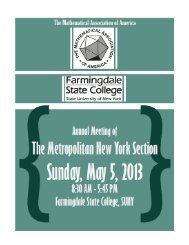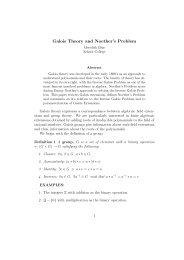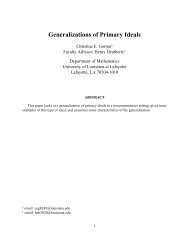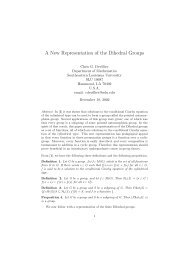Presentation Abstracts - MAA Sections
Presentation Abstracts - MAA Sections
Presentation Abstracts - MAA Sections
Create successful ePaper yourself
Turn your PDF publications into a flip-book with our unique Google optimized e-Paper software.
GT1.5 Sara Malec Georgia State University<br />
On the Intersection Algebra of Principal Ideals<br />
Given two ideals in a Noetherian ring, the intersection algebra is an object that captures some information on the<br />
relationships between those two ideals. When the ring is a UFD and the ideals are principal, we use a connection to<br />
semigroup rings to describe some properties of the intersection algebra, including an algorithm that produces its<br />
generating set.<br />
INQ.6 John Mayer University of Alabama at Birmingham<br />
Hexagon Numbers: An Open-Ended Problem<br />
An equiangular hexagon is a six-sided convex polygon all of whose internal angles are equal. Imagine that you have an<br />
unlimited supply of congruent equilateral triangles. A number of these triangles can be placed with edges adjoining<br />
(fully, not overlapping) so as to form an equiangular hexagon. The first two hexagon numbers are six and ten. Call a<br />
positive integer n a hexagon number provided that with n of your congruent equilateral triangles, you can build an<br />
equiangular hexagon. What are the hexagon numbers? We will show how, using manipulatives (pattern blocks), this<br />
problem, and others that flow from it, can be introduced to students, working individually or in collaborative groups, in<br />
grades 5-16. There are multiple entry- and exit-levels for this problem. Such problems help students understand what<br />
mathematics actually is, as a study in its own right as opposed to (merely) a tool. (Hexagon numbers are not to be<br />
confused with hexagonal numbers: The nth hexagonal number is the number of points on a regular hexagon with n<br />
regularly spaced points on a side, including the vertices.)<br />
MPE.3 Erin McNelis Western Carolina University<br />
Meaningful Modeling: Connecting Computational Science, Student Interests, and the Mathematics of Planet<br />
Earth 2013<br />
Drawing a broader audience from the sciences, our Introduction to Scientific Computing course is an ideal setting for<br />
introducing students to mathematical modeling, computational science, and interdisciplinary applications of mathematics.<br />
This semester, our course has adopted the theme of the Mathematics of Planet Earth to help raise awareness of the role<br />
mathematics plays in understanding and potentially solving problems facing our generation and generations to come. The<br />
course introduces students to a variety of models (discrete, continuous, stochastic, systems-based, individual-based,<br />
statistical, etc.) and this year the examples and applied homework projects have been developed to highlight<br />
environmental mathematics applications such as population dynamics, epidemiology and ecological succession models,<br />
natural resource modeling, and optimal land use problems. As the semester progresses, students will develop and carry<br />
out long-term projects investigating a question or theme that interests them and provides meaningful connections to their<br />
disciplines (mathematics, mathematics education, computer science, chemistry, or engineering). This presentation will<br />
identify the challenges, successes, and failures experienced in this special themed course to date and will share examples<br />
of associated environmental mathematics applications and projects, and student selected topics for long-term course<br />
projects.<br />
BEG.2 Razvan Alexandru Mezei Lander University<br />
George A. Anastassiou, University of Memphis<br />
Reverse Lp Fractional Integral Inequalities<br />
We present reverse fractional integral inequalities, in the Lp norm, for left and right Riemann-Liouville, generalized<br />
Riemann-Liouville, Hadamard, Erdelyi-Kober and multivariate Riemann-Liouville fractional integrals. Then we derive<br />
reverse Lp fractional inequalities regarding the left Riemann-Liouville, the left and right Caputo and the left and right<br />
Canavati type fractional derivatives.<br />
GT1.1 Christopher Miglino Albany State University<br />
Renu Angira (Graduate Student), Li Feng (Faculty Mentor)<br />
The Orbit Structure of the Power Sequence in Z<br />
100<br />
Let $n>0$ and Z100 [0],[ 1], n[99]<br />
be the commutative ring of all congruence classes modulo . In this paper, we study<br />
the orbit of the sequence of positive powers<br />
2 3<br />
{[ k],[ k] ,[ k] , n [ k ] n , n}<br />
,<br />
for each k<br />
Z100<br />
. We characterize if an orbit is a fixed point orbit, a periodic orbit, or an eventually periodic orbit. We<br />
study the group structures in the orbits and the relationships between the orbit structures. It is interesting that there are

















